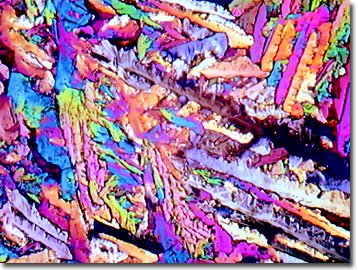Polarized Light Digital Image Gallery
Mannose
As a six-carbon simple sugar, mannose (or dextro-mannose) is a stereoisomer of glucose that is found as an uncommon, naturally occurring saccharide in some plants, particularly legumes, and other food plants. While small amounts of d-mannose are metabolized in the human body, large quantities of the hexose are excreted rapidly into the urine.

Two isomers, mannopyranose and mannofuranose, feature 6 carbons, 12 hydrogens, and 6 oxygen atoms per molecule, as does glucose, and a melting point of 132 degrees Celsius. Known also as aldohexose, mannose has a molecular weight of 180.16 and forms hexagonal ring structures with one carbon substituted with an oxygen atom and aldehyde group. The monosaccharide is found naturally in glycolipids and glycoproteins of plants, fungi, and bacteria in polymerized forms called mannans that serve as food energy stores. When phosphorylated by the enzyme hexokinase, mannose-6-phosphate is formed, which isomerizes to fructose-6-phosphate and enters into the glycolysis or gluconeogenesis metabolic pathways.
Mannose, marketed also as seminose and carubinose, is prescribed for urinary tract infections caused by the misplaced common gut bacteria, Escherichia coli. Since it is a natural sugar compound, mannose is not regulated by the United States Food and Drug Administration as a drug, but rather is classified as a nutritional supplement. In many cases of kidney or bladder infection, typical antibiotics are ineffective because the E. coli use tiny projections of lectin, a glycoprotein, from their cell walls to glue themselves to the lining of the urinary tract. It turns out that mannose sticks to the bacteria better than they stick to the urinary tract. With oral mannose, the sugar coats the bacteria so that they don't hold onto the lining and then urine is able to flush them away. Luckily, mannose is absorbed in the upper gastrointestinal tract so that beneficial E. coli of the lower intestines are not impaired. Mannose is also used in veterinary medicine for treating uterine bacterial infections because there are no unwanted side effects (including killing "good" bacteria or normal gut flora), and because the sugar avoids the developed resistance quandary posed by antibiotics and many strains of microbes. As an extra bonus, for humans and animals, mannose tastes good, reducing the problems associated with getting some patients to take their medicine.
Mannose is used in commercial fermentation and also as a fertilizer. Diabetic's sugar, marketed as mannitol or mannite, and derived from mannose, is very sweet in taste, and is combined with other artificial sweeteners in new, non-sugar products such as sugarless gums and breath mints. Broths of mannose are used to rapidly detect Salmonella infestations in dried foods and animal feeds.
Contributing Authors
Omar Alvarado, Thomas J. Fellers and Michael W. Davidson - National High Magnetic Field Laboratory, 1800 East Paul Dirac Dr., The Florida State University, Tallahassee, Florida, 32310.
BACK TO THE POLARIZED LIGHT IMAGE GALLERY
BACK TO THE DIGITAL IMAGE GALLERIES
Questions or comments? Send us an email.
© 1995-2025 by Michael W. Davidson and The Florida State University. All Rights Reserved. No images, graphics, software, scripts, or applets may be reproduced or used in any manner without permission from the copyright holders. Use of this website means you agree to all of the Legal Terms and Conditions set forth by the owners.
This website is maintained by our
Graphics & Web Programming Team
in collaboration with Optical Microscopy at the
National High Magnetic Field Laboratory.
Last Modification Friday, Nov 13, 2015 at 01:19 PM
Access Count Since September 17, 2002: 14315
Visit the website of our partner in introductory microscopy education:
|
|
